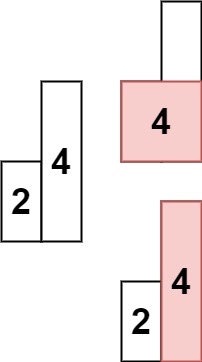Given an array of integers heights representing the histogram's bar height where the width of each bar is 1, Return the area of the largest rectangle in the histogram.
Example 1:

Input: heights = [2,1,5,6,2,3]
Output: 10
Explanation: The above is a histogram where width of each bar is 1.
The largest rectangle is shown in the red area, which has an
area = 10 units.
Example 2:

Input: heights = [2,4]
Output: 4
Constraints:
1 <= heights.length <= 10^50 <= heights[i] <= 10^4
Intuition
Need to maximize the area formed by a rectangle by combining rectangles from left and right.
If the heights of the rectangles on the left/right sides are more than or equal to the length of the current rectangle we can combine those to calculate the area and the resultant area will be the height of the current rect * width.
Width can be calculated by the distance between the indices of the chosen rightmost and the leftmost rect which is the nearest smaller to the current one.
Approach
To choose the leftmost rect we can find the
nearest smaller leftand similarlynearest smaller rightusing thestackinO(N).Store their
indicesin two vectors sayleftandright.
If there is no smaller rect in theleftwe can use-1as an index and for the rightlenas an index.The width will be equal to the
right - left - 1.Now traverse the
heightsarray and calculate theareafor every rect and store themax_area.
Complexity
Time complexity:O(N)
Space complexity:O(N)
Code
int largestRectangleArea(vector<int> &heights) {
int len = heights.size();
vector<int> left(len, -1), right(len, len);
stack<pair<int, int>> st;
// storing the indices of nearest smaller left for each element
for (int in = 0; in < len; ++in) {
if (!st.empty() && st.top().second < heights[in]) {
left[in] = st.top().first;
} else if (!st.empty() && st.top().second >= heights[in]) {
while (!st.empty() && st.top().second >= heights[in])
st.pop();
if (!st.empty())
left[in] = st.top().first;
}
st.push({in, heights[in]});
}
st = stack<pair<int, int>>();
// storing the indices of nearest right element for each element
for (int in = len - 1; in >= 0; in--) {
if (!st.empty() && st.top().second < heights[in]) {
right[in] = st.top().first;
} else if (!st.empty() && st.top().second >= heights[in]) {
while (!st.empty() && st.top().second >= heights[in])
st.pop();
if (!st.empty())
right[in] = st.top().first;
}
st.push({in, heights[in]});
}
// calculate area for every rectangle by combining the nearer left and rigt and store the maximum area.
int max_area = 0;
for (int in = 0; in < len; ++in) {
int area = heights[in] * (right[in] - left[in] - 1);
max_area = max(max_area, area);
}
return max_area;
}
Please Upvote if you found it helpful.
